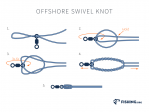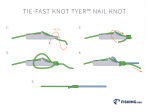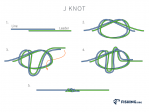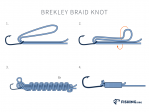Bobber stopper knots are used tying them to the fishing line, just above sliding fishing bobbers. This kind of know grips at the line, exactly where you wish for the bobber to stop. It also directs the bobber to reach the depth you wish for fishing.
Bopper stopper knots are one of the most common types of knots used today. These are really handy knots, because they can be reeled in for casting purposes. Then when the bait starts to settle at a desirable depth, the bobber can slide up the fishing line, but stopping as it hits the knot. The bobber stopper knot allows deep presentation of the bait and won't be impeded by the bobber as it is cast.
Bobber Stopper Knot

Tying Bobber Stopper Knots
A bobber stopper knot requires a tying pattern using three simple movements. Using a dacron fly line for backing is a good idea. Dacron fly line is workable, especially for the floating part where the stopper knot goes. There are also specialty tools that can be purchased for tying any bobber stopper knots. Whatever your purpose, there is a simple method of the tying of proper bobber stopper knots.
Step 1:
First make a knot approximately 6 inches from the fly line. This should be about the same diameter as your line is or made using dacron. Laying your stopper line against your fishing line, mark the chosen point and form a loop by doubling backward. Hold this loop wherever the stopper line crosses up and over itself. It should do this also across the fishing line.
Step 2:
Next make two to three turns going around both lines. Then take a pass through the opened loop, doing this once each time. You should end off, so that you have two ends created now.
Step 3:
Finally, take your fingers and pull on both ends. Pull each in the opposite direction, until it tightens. Continue pulling until the knot is formed and tightly knotted. You should now have a completed bobber stopper knot.
Our Take:
Bobber stopper knots are not the only way to create a useful fly line stopping knot. Tenkara level lines, loop to loops, and egg looks are fishing knot alternatives that are still comparable to the bobber stopper knot. Don't be afraid to try them out in similar fisher activities as needed. Enjoy using this useful knot style.
 Joshua Keaton
Joshua Keaton 








